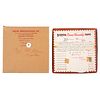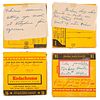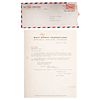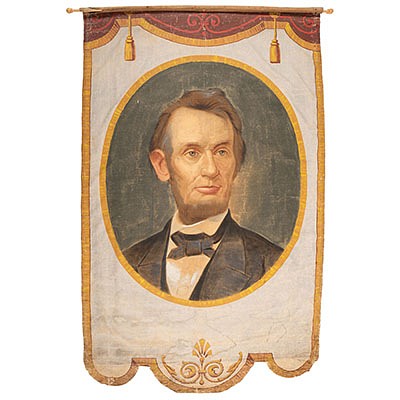[ALASKA] - [FILM]. NELSON, Charles "Red" (1900-1982). Large collection of 16mm film reels shot by Charles "Red" Nelson featuring wide array of subject
About Seller
6270 Este Ave.
Cincinnati , OH 45232
United States
With offices in Cincinnati, Cleveland and Denver, Cowan’s holds over 40 auctions each year, with annual sales exceeding $16M. We reach buyers around the globe, and take pride in our reputation for integrity, customer service and great results. A full-service house, Cowan’s Auctions specializes in Am...Read more
Two ways to bid:
- Leave a max absentee bid and the platform will bid on your behalf up to your maximum bid during the live auction.
- Bid live during the auction and your bids will be submitted real-time to the auctioneer.
Bid Increments
| Price | Bid Increment |
|---|---|
| $0 | $25 |
| $500 | $50 |
| $1,000 | $100 |
| $2,000 | $250 |
| $5,000 | $500 |
| $10,000 | $1,000 |
| $20,000 | $2,500 |
| $50,000 | $5,000 |
| $100,000 | $10,000 |
About Auction
Jun 25, 2021
The June 25 American Historical Ephemera and Photography Auction features an exciting assemblage of 18th-early 20th century material, including Civil War archives, Early Photography, Western Americana, Autographs and Manuscripts, and more. Cowan's Auctions dawnie@cowans.com
- Lot Description
Approximately 480 16mm film reels and 30 audio reels, most housed in the original canisters used for storage by Red Nelson (strong vinegar odor evident in all canisters indicating at least some degree of acetate film base degradation or "vinegar syndrome"). Content of reels was typically identified to some extent by Nelson, either with a brief note on the reel's box or with a label attached to the box. Sample identifications include: "Eskimo women cutting up meat at Kotzebue"; "Eskimo dance & singing"; "Orig. Mt. Spur [sic] Eruption"; "Kotzebue Alaska / July 20, 1951 / Stories by Charles Seavih [?]"; "Anchorage"; "Hunting the Alaska Brown Bear"; "Wolf Hunting in Alaska"; "Mt. Wrangle [sic] Smoking"; "Return to Kahiltna"; "Judge Folta Bear"; "Lady Bird Johnson's Visit"; "McKinley Park"; "Shots from the end of the cutting [Baluga?] Whale / seal in water, women cutting up sea lion"; "Car[i]bou along shore / Shevich [?] in boat sea / lion on beach / Coast of Arctic Ocean"; "Sea Gulls & Creek at Ketchican"; and "Chatinibra Bridge / Black [?] Glacier & River Timelapse." Exact dates of the collection are unknown, however, Nelson's labels indicate most material was recorded somewhere between 1940s-1960s. Provenance: Archive descended directly in the family. Consignor inherited film reels after the passing of Nelson's only grandchild.
[With:] Two letters, both dated 1947, written by an employee of Walt Disney Productions in Burbank, CA, and addressed to Red, discussing the possibility of utilizing Red's films in Disney productions.
[Also with:] DVD and USB flash drive containing digitized film footage from a sample selection of 12 reels in the collection. See lot description at cowans.com for link to the 1-hour sample reel of digitized footage.
“Red” Nelson was an Alaska adventurer, sportsman, hotel owner, and railroad man but most of all – a photographer and filmmaker. A “citizen journalist” of his time, he documented Alaska's indigenous people, the ’64 earthquake, Mt. Spurr’s ’53 eruption and ashfall, train derailments, gold prospectors, his beloved Mt. McKinley (Denali), and much more. Born in New York in 1900, he left home at age 12 with only an elementary education and worked odd jobs throughout the Pacific Northwest. Traveling to towns across southern Alaska, he eventually settled in Anchorage, working on the Alaska Railroad. His last day was July 3, 1937. Just three days later, on July 6, he signed the papers to buy the Inlet Hotel in Anchorage in the afternoon and married Vera Pettingill that night. In 1940, The Alaskan newspaper reported that Red became the first Alaskan photographer to receive national recognition when two of his landscapes received awards from the Photographer’s Association of America. For decades, Red lived and worked in Alaska, operating his hotel while photographing and shooting films that documented his cherished Alaskan wilderness and culture. When the devastating Good Friday earthquake of March 1964 destroyed half of Anchorage and damaged the Inlet Hotel, Red was prompted to relocate his family to California where he continued pursuing both photography and filmmaking.
The enormous trove of recordings offered here represents a unique visual and audio diary of Alaskan life and wilderness, and a potentially significant contribution to the body of ethnographic films related to Alaska's indigenous peoples. The man identified as "Chester Seavih" on several film reels is likely Chester Seveck, Chief Herder for Alaska Reindeer Service and an Alaskan native who some speculate was the inspiration for the Alaska Airlines logo. A smaller selection of footage in the archive was shot in California and other locations, and includes, in part, reels identified as "Disneyland / Sept. 1956," Miss Universe 1957, 1958, and 1959, "International Beauty Congress 1960 - Long Beach California," "1960 Surfing / Sept 25 1960 / Huntington Beach Calif," "South Seas," and "Yellowstone / Oct 1962."
Please note that owing to indications of "vinegar syndrome," as is common for reels of this age, we can make no guarantee about the transferability of the reels.
Red's work is rare. OCLC locates only one institution, the Anchorage Museum at Rasmuson, with his photography in its collections and no other institutions were identified as housing his films or audio reels. Rare Book Hub identifies no Nelson material at auction. See also Lot 389. - Shipping Info
-
SHIPPING & PICKUPS Cowan’s Cincinnati Office offers an in-house, full-service shipping department which is unparalleled in the auction industry. Shipping costs are provided with your finalized invoice 24-48 hours after auction. For furniture and oversized items, we recommend using third-party services. For more information, contact cowansshipping@hindmanauctions.com. NOTE: All pickups and preview are by appointment only. To make an appointment, please call 513-871-1670 or email cincinnati@hindmanauctions.com Buyers are required to pay for all packing, shipping and insurance charges. Overseas duty charges are the responsibility of the successful Bidder. Be aware that for larger and/or valuable items, shipping charges can be substantial. - Shipping charges include insurance for your order while in transit. If you have private insurance we will adjust your charge to include only packing and shipping. - Please allow 14 – 21 days after payment to package and ship your purchase as carefully as possible.
-
- Buyer's Premium



 EUR
EUR CAD
CAD AUD
AUD GBP
GBP MXN
MXN HKD
HKD CNY
CNY MYR
MYR SEK
SEK SGD
SGD CHF
CHF THB
THB![[ALASKA] - [FILM]. NELSON, Charles "Red" (1900-1982). Large collection of 16mm film reels shot by Charles "Red" Nelson featuring wide array of subject](https://s1.img.bidsquare.com/item/l/8590/8590693.jpeg?t=1LMYw7)
![[ALASKA] - [FILM]. NELSON, Charles "Red" (1900-1982). Large collection of 16mm film reels shot by Charles "Red" Nelson featuring wide array of subject](https://s1.img.bidsquare.com/item/s/8590/8590693.jpeg?t=1LMYw7)













